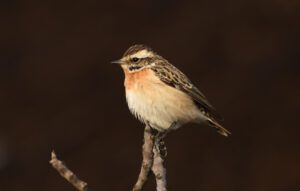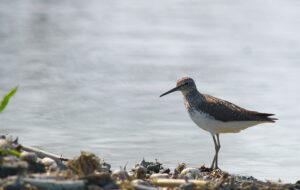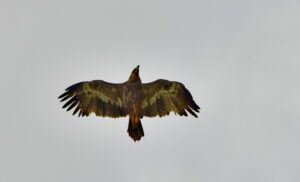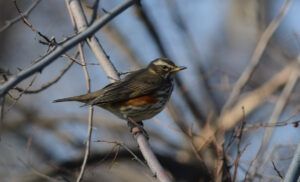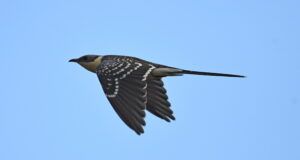The Crested Lark (Galerida cristata) is a species of lark distinguished from the other 81 species of lark by the crest of feathers that rise up in territorial or courtship displays and when singing. Common to mainland Europe, the birds can also be found in northern Africa and in parts of western Asia and China. It is a non-migratory bird, but can occasionally be found as a vagrant in Great Britain.
The Crested Lark was one of the many species originally described by Linnaeus in his 18th century work, Systema Naturae. He gave it the binomial name Alauda cristata. German naturalist Friedrich Boie placed it in the new genus Galerida in 1821, but did not define what characters distinguished in from larks in the genus Alauda. C.J.O. Harrison recommended sinking members of Galerida and Lullula back into Alauda in 1865 due to lack of defining characters. Alban Guillaumet and colleagues noted the distinctiveness of populations from the Maghreb – birds in the dryer parts of Morocco and Tunisia had longer bills while those in more coastal northern parts had shorter bills typical of the European subspecies. The authors sampled the mitochondrial DNA and found they were distinct genetically. The Maghreb Lark, comprising subspecies macrorhyncha and randonii, has been found to have diverged 1.9 million years ago and is regarded now by the IOC as a separate species.
There are 37 known subspecies of Crested Lark:
- Galerida cristata cristata
- Galerida cristata pallida
- Galerida cristata neumanni
- Galerida cristata apuliae
- Galerida cristata tenuirostris
- Galerida cristata meridionalis
- Galerida cristata caucasica
- Galerida cristata subtaurica
- Galerida cristata cypriaca
- Galerida cristata zion
- Galerida cristata cinnamomina
- Galerida cristata magna
- Galerida cristata leautungensis
- Galerida cristata coreensis
- Galerida cristata iwanowi
- Galerida cristata lynesi
- Galerida cristata kleinschmidti
- Galerida cristata riggenbachi
- Galerida cristata carthaginis
- Galerida cristata balsaci
- Galerida cristata arenicola
- Galerida cristata helenae
- Galerida cristata festae
- Galerida cristata brachyura
- Galerida cristata nigricans
- Galerida cristata maculata
- Galerida cristata halfae
- Galerida cristata senegallensis
- Galerida cristata jordansi
- Galerida cristata alexanderi
- Galerida cristata isabellina
- Galerida cristata altirostris
- Galerida cristata somaliensis
- Galerida cristata tardinata
- Galerida cristata chendoola
- Galerida cristata randoni
- Galerida cristata macrorhyncha
- Description
A fairly small lark, the Crested Lark is roughly the same size as a Eurasian Skylark, but shorter overall and bulkier around the head and body, and very similar in appearance, with a height of 17 cm and a wingspan of 29 to 38 cm, weighing between 37 and 55g. It is a small, brown bird and has a short tail with light brown outer feathers. Male and females have no real differences, however young Crested Larks have more spots on their back than their older counterparts. Its plumage is downy but sparse and appears whitish. The distinct crest from which the Crested Lark gets its name is conspicuous at all times but is more pronounced during territorial or courtship displays and when singing. In flight it shows reddish underwings. It shares many characteristics with the Thekla Lark, with the main distinctions between the two being the Thekla’s heavier black-brown streaks and its grey underwing, present in European specimens.
Distribution and habitat
The Crested Lark breeds across most of temperate Eurasia from Portugal to northeast China and eastern India, and in Africa south to Niger. It is non-migratory, and the sedentary nature of this species is illustrated by the fact that it is only a very rare vagrant to Great Britain, despite breeding as close as northern France. While the bird is not commonly found in Scandinavia today, it could be found in Sweden until the 1990s, with sources reporting six individual birds in 1992 before becoming extinct in Sweden in 1993. The birds have also gone extinct in several other European countries, including Norway (1972), Luxembourg (1973) and Switzerland (1980s).
This is a common bird of dry, open country and is often seen by roadsides or in cereal fields, although it is also found occupying small, sandy patches by railways, docks and airfields.
The Crested Lark is a songbird, and has a liquid, warbling song described onomatopoeically as a “whee-whee-wheeoo” or a “twee-tee-too”. It sings in flight from high in the sky, at roughly 30 to 60 metres above the ground. The related Skylark exhibits similar behaviour but also sings during its ascent, whereas the Crested Lark sings either at altitude or on the ground. Their flight pattern is an example of undulatory locomotion.
It nests in small depressions in the ground, often in wastelands and on the outskirts of towns. The nests are untidy structures composed primarily of dead grasses and roots. Three to five brown, finely speckled eggs, similar to those of the Skylark, are laid at a time and will hatch after 11–12 days. As with most larks, the chicks move leave the nest early, after about eight days and take flight after reaching 15–16 days old. Two broods will usually be raised each year.
Largely vegetarian birds, the Crested Lark primarily feeds on grains and seeds, such as oats, wheat and barley,but will also eat insects, particularly beetles,with food either being scavenged from the ground or dug up. Juvenile birds are fed by both parents, and generally leave the nest before they are able to fly to start foraging for food themselves.
Relationship to humans
Francis of Assisi considered the Crested Lark a bird of special significance, based on similarities he perceived between it and the life of the Friars Minor: its plain earth-colored plumage and hood, its humility (“for it goes willingly along the wayside and finds a grain of corn for itself”), and its time spent in song.
Status
The Crested Lark has been categorised by the IUCN Red List of Threatened Species as being of Least Concern, meaning that it is not currently threatened with extinction. Estimates for the global population of mature individuals of the species range from 22,000,000 to 91,200,000. Figures for Europe are less varied, with estimates putting the number of breeding pairs at between 3,600,000 and 7,600,000, or between 7,200,000 and 15,200,000 individuals. In Europe, trends since 1982 have shown an overall decline in the population of the species, resulting in the assumption that the Crested Lark is in decline globally.
photo: Mihai BACIU


